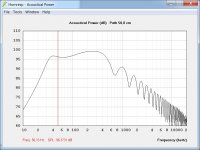From the MJK link above #6
"One objection heard often with respect to higher Qts drivers in OB designs is that
the bass transient response will ring and produce a bloated one note bottom end. Figure
8 shows the impulse responses for the three Eminence drivers in the OB design from
Figure 7. Again there is not much difference in the shape of the three curves. The only
significant difference is the increasing length of the transient response with increasing
Qts, but since the Alpha 15A woofer extends lower in the frequency domain it should
also have a slightly longer transient response in the time domain. There is no evidence
of excessive ringing bass response from any of these three drivers. Once again, the
better OB low frequency performance is achieved with the higher Qts Eminence Alpha
15A woofer. "
I Know I have to do my own experience, but I hope to get the number of possible drivers down to two or three. Strassacker also claims that low Qt drivers generally are the best drivers, but they still aim for higher Qt, and they do it by adding a series resitor.
So there are a lot of possibilities to try (but that's part of the fun right)
"One objection heard often with respect to higher Qts drivers in OB designs is that
the bass transient response will ring and produce a bloated one note bottom end. Figure
8 shows the impulse responses for the three Eminence drivers in the OB design from
Figure 7. Again there is not much difference in the shape of the three curves. The only
significant difference is the increasing length of the transient response with increasing
Qts, but since the Alpha 15A woofer extends lower in the frequency domain it should
also have a slightly longer transient response in the time domain. There is no evidence
of excessive ringing bass response from any of these three drivers. Once again, the
better OB low frequency performance is achieved with the higher Qts Eminence Alpha
15A woofer. "
I Know I have to do my own experience, but I hope to get the number of possible drivers down to two or three. Strassacker also claims that low Qt drivers generally are the best drivers, but they still aim for higher Qt, and they do it by adding a series resitor.
So there are a lot of possibilities to try (but that's part of the fun right)
I don´t know where you found those words. I have never written them.
What is the difference between a Qts of 1,0 and 0,2???
I know you haven't written it here at this forum;o)
Difference is 0,8?
Joke aside, the difference is a dipole driver and a horn driver.
With a fs at 40, qes at 0.2 and 5mm stroke, I believe there is no head room until distortion sets in, just my own experience. Even +3-4 db eq under 40Hz is painful for both speakers and amp….
Well, it doesn't matter for me. Each to their own!
Peter
View attachment 465916
Which driver do you think needs most power for general music (not pure home theater sub)?
So Johannes, you mean you will listen to the JBL bass with a x-over at 3-400Hz as it is?
No way, my experience is to get a decent balance of bass and lower mids is to get the X-over as low as 70-80Hz 12-24db/octave in the bass. All depending on driver of course and two-way, three-way what ever...
Ae dipole drivers are also made for use without DSP. It means one can use less amp power. Good or not, it's up for the usual dogma at current belief. Besides, the Dipole 15 have double the stroke and half of the JBL fs.
Some people prefer the IB15HT in ob, even longer stroke and lower fs….
Peter
Hi Everyone,
As with most things speaker related, there is often a lot of misconception when it comes to open baffles. First off, there are two things to contend with on the low end. One is the baffle rolloff and the other is the rolloff of the woofer itself. In an ideal situation, the woofer will add not additional rolloff to the system. The only rolloff to contend with will then be the rolloff of the baffle itself. As this baffle rolloff is the same no matter which woofer is on the baffle, we can ignore this aspect for now and focus only on the woofer.
There are two schools of thought when it comes to open baffles. One wishes for a lower Q of .5 or less. The thought here is for a more well damped, controlled, tight response. The other school of thought is for a Q of 1.2 or higher. This higher Q creates a bump in response that will help compensate for the baffle rolloff. There are issues with both based on drivers used in standard applications so optimizing a driver for this application really gives the best of both worlds.
It is known that a driver with Qts around .707 naturally gives the lowest possible F3 point. As a result, staying somewhere between those Q points of .5 and .12 is really more ideal if we want a low natural F3 point. There is desire for the woofer to be efficient, but efficiency down low is a priority over the upper end efficiency. In an open baffle you have far more rolloff from the baffle than in any boxed alignment. At 25hz there may be 15-20dB of baffle rolloff to contend with. As a result, this is where the efficiency is needed instead of up at 80-100hz. In an ideal situation the woofer itself should have a natural F3 point close to, or even below the lowest frequency you desire to play with the system. If this can be achieved, there will be no additional rolloff provided by the woofer itself.
Lets look at a few different woofers here to see what they look like in an infinite baffle first. The transfer function of the open baffle is the same no matter which woofer is used so we can easily compare them this way.
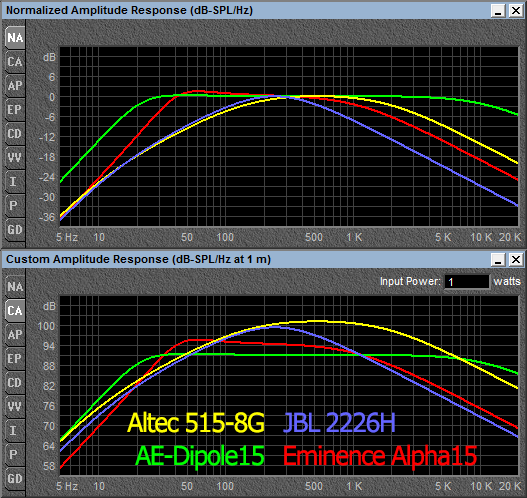
This graph shows several woofers that are used in open baffle use. You can easily compare other similar woofers as well. First looking at a small signal normalized response on top is telling of where the woofers begin to roll off. The Dipole15 has an F3 point of 19.5Hz, Alpha15 32.6Hz, 2226H 104.9Hz, and 5158G 130hz. Of course this is only the normalized response but it is important. If the baffle has 15dB of rolloff at 25hz and the woofer then adds another 15dB of rolloff at 25hz, that means there is 30dB of compensation required to be flat to that point.
Secondly, looking at the amplitude response is even more critical. At 25hz, the Dipole15 is 90.2dB 1W, Alpha15 is 86.5dB, 2226H is 84.2dB, and 85.6dB. This means that at 25Hz with 1W input, the Dipole15 is 3.7dB more efficient than the next closest woofer. Getting to any specific level at 25hz requires less than half the power than with all the other woofers. It isn't until above 32hz that the Alpha15 has an advantage. The Dipole15 is more efficient than the 2226H or 5158G everywhere below 50hz even though their rated 1w/1m efficiency is higher. Based on what is going on here at 1W input it is clear to see why the Dipole15 is already going to be the best option with low end output and the Alpha15 coming in close if you don't want to go below 30hz.
That however is only at 1W levels. The parameters in a woofer change with excursion, so we need to take this into account. This is more critical in an open baffle where the woofer needs to play to higher excursions to compensate for the baffle rolloff. Remember that at 25hz the response may be 15-20dB down depending on baffle size. This means the woofer has to operate at very high excursions compared to what it would do in a sealed enclosure to make up for that difference.
The Alpha15 has a short 3.8mm Xmax. At this point, Bl has dropped by 30% and suspension stiffness has gone way up. Lowering both Bl and Cms means the Q of the driver goes up. In this case it was 1.2 at the rest position. At 3.8mm the Qts of the driver has gone up to nearly 3.0! This is a huge issue and has a huge effect on response. The Dipole15 though was purposely designed with a long throw underhung motor. This underhung motor not only gives it an optimal Qts to begin with, but keeps the Qts nearly the same within the 12mm Xmax. The suspension allows for upwards of 22mm one way travel so compliance has almost no change within the 12mm one way Xmax. The Qts is still in the middle of that optimal range with the Dipole15. As a result, when 20w is input the Dipole15 and Alpha15 now compare like this:
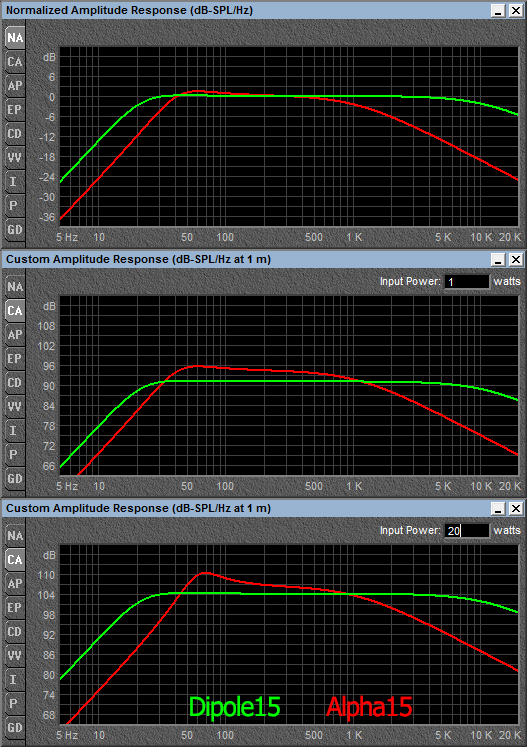
This illustrates a few things. One, the huge bump in response explains exactly why this type of high Q system can sound boomy. The high Q provides a big, poorly damped response that is now elevated up in the 50-70hz range. Secondly, the low end response has actually decreased due to this change in Q. The Dipole15 now has a much more significant advantage down low. Also realize that this change in response as seen in the Alpha15 happens on every inward and outward stroke with the response returning to normal as the coil travels though its center point. This means big distortion.
In addition, there should be some discussion of the overall displacement capability. The Alpha15 has only 3.8mm Xmax, 515G 4.3mm, 2226H 7.6mm Xmax, while the Dipole15 has 12mm displacement. A single Dipole15 can more accurately displace more air than almost 4x of the Alpha15, 3x of the 5158G, or almost 2 of the 2226H. This is simply a function of the woofer being optimized for this application while the others are not.
From a low end efficiency standpoint and maximum output standpoint, the Dipole15 stands out from the others. The biggest advantage though is in terms of the low distortion of the woofer. The Bl curve is very flat due to the underhung design. The Q is not greatly changing with every inward and outward stroke as seen in the Alpha15. In addition to that is the effect of the inductance curve and the attention put on lowering flux modulation. Eliminating the flux modulation means the motor has much more control on the position of the coil with respect to time. This is seen in multi-tone distortion tests which are a much better representation of real world scenarios than simple sweeps. The full copper Faraday sleeve on the pole forces the coil to operate as an air core at all points of travel. This means the Le(x) curve is nearly identical at all excursions. You can see a measurement of the LO15 Le(x) curve here along with the comments:
https://sites.google.com/site/drivervault/driver-measurements/15/ae-speakers-lo15/le-x
That all said, there was a lot of attention put into the Dipole15 for this application. Ever aspect of it was tweaked for this type of use. There is a reason some of the most well renown speakers in the world are using the Dipole woofers.
KYRON KRONOS: Loudspeaker of the Year Over $20,000 | Sound+Image | News | AVHub
Kyron Audio - Audio Reproduction Redefined | Audiophile Dipole Loudspeakers
SoulSonic Speakers
Granada - Breathing Life Into Music
Martin King also claimed the Dipole15 "probably the best dipole woofer money can buy" on his reference project.
Project 10 : Lowther Open Baffle / Acoustic Elegance H Frame System
Hopefully this all sheds some light on things regarding the woofers. Discussion of the baffle itself is a completely different topic.
-John
As with most things speaker related, there is often a lot of misconception when it comes to open baffles. First off, there are two things to contend with on the low end. One is the baffle rolloff and the other is the rolloff of the woofer itself. In an ideal situation, the woofer will add not additional rolloff to the system. The only rolloff to contend with will then be the rolloff of the baffle itself. As this baffle rolloff is the same no matter which woofer is on the baffle, we can ignore this aspect for now and focus only on the woofer.
There are two schools of thought when it comes to open baffles. One wishes for a lower Q of .5 or less. The thought here is for a more well damped, controlled, tight response. The other school of thought is for a Q of 1.2 or higher. This higher Q creates a bump in response that will help compensate for the baffle rolloff. There are issues with both based on drivers used in standard applications so optimizing a driver for this application really gives the best of both worlds.
It is known that a driver with Qts around .707 naturally gives the lowest possible F3 point. As a result, staying somewhere between those Q points of .5 and .12 is really more ideal if we want a low natural F3 point. There is desire for the woofer to be efficient, but efficiency down low is a priority over the upper end efficiency. In an open baffle you have far more rolloff from the baffle than in any boxed alignment. At 25hz there may be 15-20dB of baffle rolloff to contend with. As a result, this is where the efficiency is needed instead of up at 80-100hz. In an ideal situation the woofer itself should have a natural F3 point close to, or even below the lowest frequency you desire to play with the system. If this can be achieved, there will be no additional rolloff provided by the woofer itself.
Lets look at a few different woofers here to see what they look like in an infinite baffle first. The transfer function of the open baffle is the same no matter which woofer is used so we can easily compare them this way.

This graph shows several woofers that are used in open baffle use. You can easily compare other similar woofers as well. First looking at a small signal normalized response on top is telling of where the woofers begin to roll off. The Dipole15 has an F3 point of 19.5Hz, Alpha15 32.6Hz, 2226H 104.9Hz, and 5158G 130hz. Of course this is only the normalized response but it is important. If the baffle has 15dB of rolloff at 25hz and the woofer then adds another 15dB of rolloff at 25hz, that means there is 30dB of compensation required to be flat to that point.
Secondly, looking at the amplitude response is even more critical. At 25hz, the Dipole15 is 90.2dB 1W, Alpha15 is 86.5dB, 2226H is 84.2dB, and 85.6dB. This means that at 25Hz with 1W input, the Dipole15 is 3.7dB more efficient than the next closest woofer. Getting to any specific level at 25hz requires less than half the power than with all the other woofers. It isn't until above 32hz that the Alpha15 has an advantage. The Dipole15 is more efficient than the 2226H or 5158G everywhere below 50hz even though their rated 1w/1m efficiency is higher. Based on what is going on here at 1W input it is clear to see why the Dipole15 is already going to be the best option with low end output and the Alpha15 coming in close if you don't want to go below 30hz.
That however is only at 1W levels. The parameters in a woofer change with excursion, so we need to take this into account. This is more critical in an open baffle where the woofer needs to play to higher excursions to compensate for the baffle rolloff. Remember that at 25hz the response may be 15-20dB down depending on baffle size. This means the woofer has to operate at very high excursions compared to what it would do in a sealed enclosure to make up for that difference.
The Alpha15 has a short 3.8mm Xmax. At this point, Bl has dropped by 30% and suspension stiffness has gone way up. Lowering both Bl and Cms means the Q of the driver goes up. In this case it was 1.2 at the rest position. At 3.8mm the Qts of the driver has gone up to nearly 3.0! This is a huge issue and has a huge effect on response. The Dipole15 though was purposely designed with a long throw underhung motor. This underhung motor not only gives it an optimal Qts to begin with, but keeps the Qts nearly the same within the 12mm Xmax. The suspension allows for upwards of 22mm one way travel so compliance has almost no change within the 12mm one way Xmax. The Qts is still in the middle of that optimal range with the Dipole15. As a result, when 20w is input the Dipole15 and Alpha15 now compare like this:

This illustrates a few things. One, the huge bump in response explains exactly why this type of high Q system can sound boomy. The high Q provides a big, poorly damped response that is now elevated up in the 50-70hz range. Secondly, the low end response has actually decreased due to this change in Q. The Dipole15 now has a much more significant advantage down low. Also realize that this change in response as seen in the Alpha15 happens on every inward and outward stroke with the response returning to normal as the coil travels though its center point. This means big distortion.
In addition, there should be some discussion of the overall displacement capability. The Alpha15 has only 3.8mm Xmax, 515G 4.3mm, 2226H 7.6mm Xmax, while the Dipole15 has 12mm displacement. A single Dipole15 can more accurately displace more air than almost 4x of the Alpha15, 3x of the 5158G, or almost 2 of the 2226H. This is simply a function of the woofer being optimized for this application while the others are not.
From a low end efficiency standpoint and maximum output standpoint, the Dipole15 stands out from the others. The biggest advantage though is in terms of the low distortion of the woofer. The Bl curve is very flat due to the underhung design. The Q is not greatly changing with every inward and outward stroke as seen in the Alpha15. In addition to that is the effect of the inductance curve and the attention put on lowering flux modulation. Eliminating the flux modulation means the motor has much more control on the position of the coil with respect to time. This is seen in multi-tone distortion tests which are a much better representation of real world scenarios than simple sweeps. The full copper Faraday sleeve on the pole forces the coil to operate as an air core at all points of travel. This means the Le(x) curve is nearly identical at all excursions. You can see a measurement of the LO15 Le(x) curve here along with the comments:
https://sites.google.com/site/drivervault/driver-measurements/15/ae-speakers-lo15/le-x
That all said, there was a lot of attention put into the Dipole15 for this application. Ever aspect of it was tweaked for this type of use. There is a reason some of the most well renown speakers in the world are using the Dipole woofers.
KYRON KRONOS: Loudspeaker of the Year Over $20,000 | Sound+Image | News | AVHub
Kyron Audio - Audio Reproduction Redefined | Audiophile Dipole Loudspeakers
SoulSonic Speakers
Granada - Breathing Life Into Music
Martin King also claimed the Dipole15 "probably the best dipole woofer money can buy" on his reference project.
Project 10 : Lowther Open Baffle / Acoustic Elegance H Frame System
Hopefully this all sheds some light on things regarding the woofers. Discussion of the baffle itself is a completely different topic.
-John
Secondly, looking at the amplitude response is even more critical. At 25hz, the Dipole15 is 90.2dB 1W, Alpha15 is 86.5dB, 2226H is 84.2dB
You can not compare one driver at 15 Hz below Fs and another 3 Hz above Fs as the only point of interest. A low Qts, high Bl driver like JBL 2226 and B&C 15NW100 will be much more efficient over Fs and the rest of the usable frequencies.
If i only want to play tones below 30 Hz then i would probably choose several Dipole 18, but if i want to play music i would go with a B&C15NW100 or two.
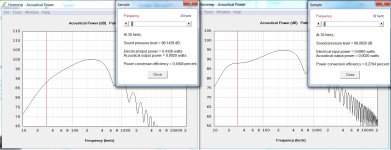
Already at 30 Hz the B&C 15NW100 (left) has a higher efficiency then the Dipol 15 (right). The efficiency is higher all the way up to 500 Hz or so.
So for pure 20 - 25 Hz tones the Dipol 15 will be a better choice.
For music pro drivers like the B&C 15TBX100, 15NW100 etc works just as well or even better dependent on your taste and economy.
I am quite certain that a B&C 15NW100 can take 2 watts of power and 3,5 mm cone-displacement without excessive distortion. The cone-displacement is the same for any 15 inch driver trying to reproduce 95 dB at 30 Hz (same baffle).
The only way to lower cone-displacement for any given spl at a specific frequency is to add radiating surface (bigger and/or more drivers).
Cheers,
Johannes
The only way to lower cone-displacement for any given spl at a specific frequency is to add radiating surface (bigger and/or more drivers).
Cheers,
Johannes
A lot of opinions - that's great. I knew it would come, and it's more than welcome.
Troels also favours PRO audio over high Q low Fs, but also because he favours high sensitivity = +94 dB to match the midrange and tweeter.
OB9
No distortion measures, only a visual confirmation that the driver do not move a lot.
Troels also favours PRO audio over high Q low Fs, but also because he favours high sensitivity = +94 dB to match the midrange and tweeter.
OB9
No distortion measures, only a visual confirmation that the driver do not move a lot.
Last edited:
This illustrates a few things. One, the huge bump in response explains exactly why this type of high Q system can sound boomy. The high Q provides a big, poorly damped response that is now elevated up in the 50-70hz range.
John,
First of all, thanks for this greatly informative post !
I think it goes without saying that a OB-optimized, long stroke woofer as the Dipole 15 is vastly superior to something like Alpha 15. However, I've never measured such an excursion-dependent hump on my Alphas: that can well be because I've never _really_ reached 3.8 mm excursion at 50-70 Hz - partly because I don't listen/measure that loud, partly because the Alpha does not need that much EQ in that area (it is, however, much easier to reach the Xmax limit at say 30Hz and that _is_ very audible).
So I was curious: are the above graphs simulations (as I believe)? If yes, I would argue they do look significantly scarier than in real life for most people listening in not so big rooms at not so high levels
View attachment 466058
Is the spl-respons from a JBL 2227H in a 10000 cm2 open baffel (sim above) bad in any way?
Why would i not want to listen to it?
Ehh, I think above sim is dipole 15 or?
This is one under to the right is JBL according to your earlier post…...
http://www.diyaudio.com/forums/atta...fle-woofer-what-important-lo15-vs-jbl2227.jpg
Anyway, sorry,bad wording from me! I'm sure that lower midrange is excellent in 2227H. What I mean to say is that the high efficiency is more or less thrown away in order to have some decent balance between lower bass and lower midrange. With a passive x-over, it will take enormous coils to fix the rising response. For an active DSP solution it's easier of course.
But all other equal, distortion, efficiency and flat response in the real room, why not make it easier and go for an optimised driver???
Further on I would like to say that I'm aware of high excursion, high efficient drivers work in ob also. As you say, one need more of them and more eq. It's just that it's getting expensive and space consuming.
Peter
@John Janowitz: Thanks for time spent on your post!!!
Last edited:
There is no EQ in the OB-sim of the JBL 2227.
You just modify an existing amp or diy an amp to have a 30 - 50 ohm output impedance.
No losses, no EQ, much less distortion and you keep the very high efficiency and clean sharp transient response gained by a strong motor (high Bl).
High Bl, low Qes and current drive is a magic combination. Please test it!
My Beyma 12P80Nd sounds very very good in an OB.
Cheers,
Johannes
You just modify an existing amp or diy an amp to have a 30 - 50 ohm output impedance.
No losses, no EQ, much less distortion and you keep the very high efficiency and clean sharp transient response gained by a strong motor (high Bl).
High Bl, low Qes and current drive is a magic combination. Please test it!
My Beyma 12P80Nd sounds very very good in an OB.
Cheers,
Johannes
What I mean to say is that the high efficiency is more or less thrown away in order to have some decent balance between lower bass and lower midrange
1 watt into a JBL 2227H in an 10000 cm2 open baffle (1 pi, combined response with 50 cm path length difference) will give 96,8 dB at 40 Hz. I don´t call 40 Hz "lower midrange" or "midbass". It is bass. Why should this be soo difficult to balance?
1 watt into a JBL 2227H in an 10000 cm2 open baffle (1 pi, combined response with 50 cm path length difference) will give 96,8 dB at 40 Hz. I don´t call 40 Hz "lower midrange" or "midbass". It is bass. Why should this be soo difficult to balance?
No it's not difficult. But you have a tendency to through out simulations and not mentioning what is simmed. Squeeze in the IB15 or any of AE's long throw drivers and see where it takes you with current drive.
Myself, I have invested in attached machina and will not change the nearest years
6-Kanal DSP-Vollverstärker mit 1-6 Endstufen - Sitronik Industrie
Do you use current drive + JBL in ob now or???
You can not compare one driver at 15 Hz below Fs and another 3 Hz above Fs as the only point of interest. A low Qts, high Bl driver like JBL 2226 and B&C 15NW100 will be much more efficient over Fs and the rest of the usable frequencies.
If i only want to play tones below 30 Hz then i would probably choose several Dipole 18, but if i want to play music i would go with a B&C15NW100 or two.
View attachment 466056
Already at 30 Hz the B&C 15NW100 (left) has a higher efficiency then the Dipol 15 (right). The efficiency is higher all the way up to 500 Hz or so.
So for pure 20 - 25 Hz tones the Dipol 15 will be a better choice.
For music pro drivers like the B&C 15TBX100, 15NW100 etc works just as well or even better dependent on your taste and economy.
Unfortunately this is just completely wrong. I would suggest not trying to force Hornresp to model an open baffle. Something is clearly not correct. The shape of the rolloff is not even realistic. We are taking the 1st order rolloff of the sealed box and adding the rolloff of an open baffle. Nowhere does this possibly come to the shape you have shown in your graphs. You have something that is showing a high Q rolloff with a bump that simply does not exist. Simple models of the woofers in an infinite baffle show the following in an infinite baffle.
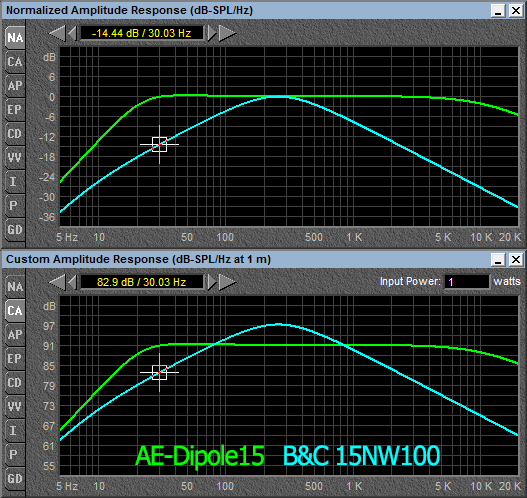
At 30hz the Dipole15 is a full 8dB more efficient. It is not until over 80hz that the B&C has any advantage at all. Response of the B&C is 82.9dB at 30hz before the baffle effect is taken into account.
To get the full idea, we model the baffle itself. The Edge is a good baffle simulator. In this case I used 24" or 609mm wide. The height is 1200mm but really isn't too critical in this case.
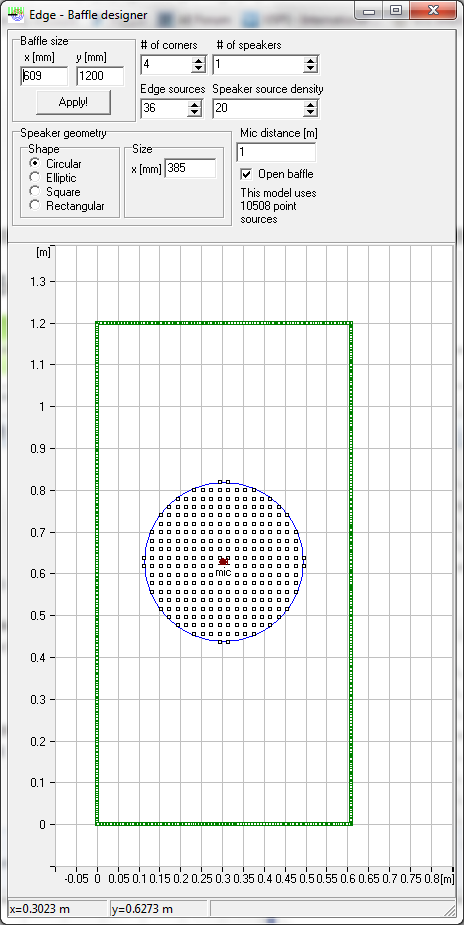
The baffle response then looks like this:

We can then export that baffle response and import as acoustic data into bassbox. The result shows both drivers simulated on the baffle
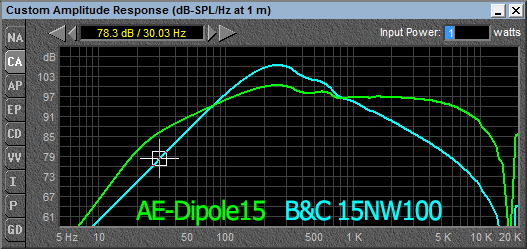
The response at 30hz is actually only 78.3dB 1W for the B&C vs 86.3dB for the Dipole15.
To get 95dB at 30hz then requires 50W input to the B&C. To do the same with the Dipole15 requires only 8W. In fact it is very difficult to take advantage of all of the excursion of the B&C driver even at 30hz. The suspension is just far too stiff. To use all 9mm of travel at 30hz requires an input power of 350W. Not only does the Dipole15 have more maximum output because of the higher Xmax, but it gets to that level with much less power. You can see the excursion and output comparison here. It takes only 100W vs 350W and at the same time the output is 2.6dB more.
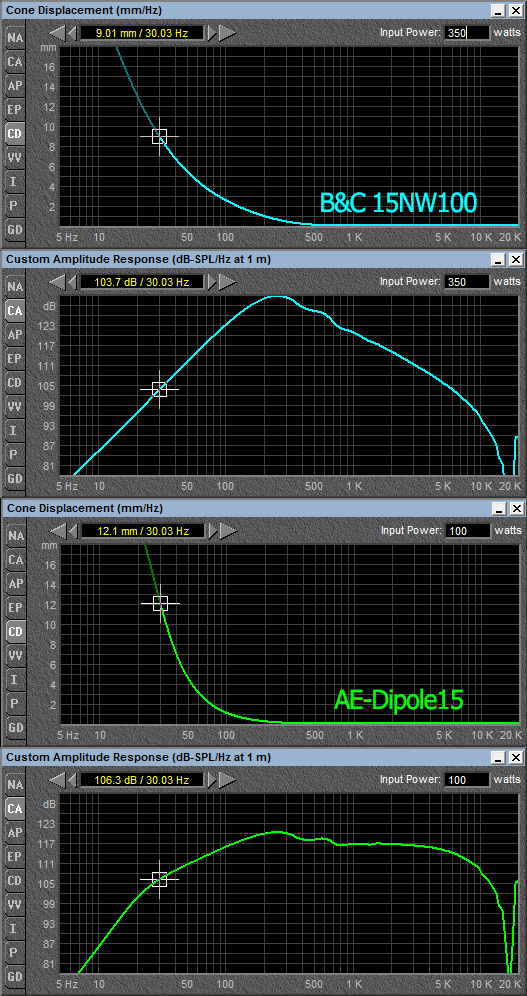
Again, this is all simply a function of creating a driver that is optimal for this application.
Once again you dont look at the whole picture.
An "8" ohm driver has 100 - 200 ohm impedans near Fs. Please drop 2,83=1w. It does not apply. Since when does Hornresp fail predicting the spl responce from a simple OB? My experience is that Hornresp is very precise.
Can those programs simulate a B&C 15NW100 with 10 or 20 ohm series resistance?
I cant understand how you can believe a weak motor should be as efficient or even more efficient as a strong motor at moving a mass against a very weak resistance (air).
Cheers, Johannes
An "8" ohm driver has 100 - 200 ohm impedans near Fs. Please drop 2,83=1w. It does not apply. Since when does Hornresp fail predicting the spl responce from a simple OB? My experience is that Hornresp is very precise.
Can those programs simulate a B&C 15NW100 with 10 or 20 ohm series resistance?
I cant understand how you can believe a weak motor should be as efficient or even more efficient as a strong motor at moving a mass against a very weak resistance (air).
Cheers, Johannes
Once again you dont look at the whole picture.
An "8" ohm driver has 100 - 200 ohm impedans near Fs. Please drop 2,83=1w. It does not apply. Since when does Hornresp fail predicting the spl responce from a simple OB? My experience is that Hornresp is very precise.
Can those programs simulate a B&C 15NW100 with 10 or 20 ohm series resistance?
I cant understand how you can believe a weak motor should be as efficient or even more efficient as a strong motor at moving a mass against a very weak resistance (air).
Cheers, Johannes
Not every 8ohm driver has a 100-200ohm impedance at Fs. This is a function of the Q of the driver. A low Q driver will have a much taller impedance peak. A higher Q driver has much less of a peak. Look at the impedance model below which will give you better understanding.
Modelling at 1W is actually much more favorable to the B&C woofer. It is not taking into account the additional sensitivity into a lower impedance load. If we compare at 2.83V we can look at both the dual 8ohm with coils in parallel (green), the dual 16ohm with coils in parallel (magenta) and the 15NW100 (lt blue). In no case is the 15NW100 going to ever be more efficient down low than the Dipole15.
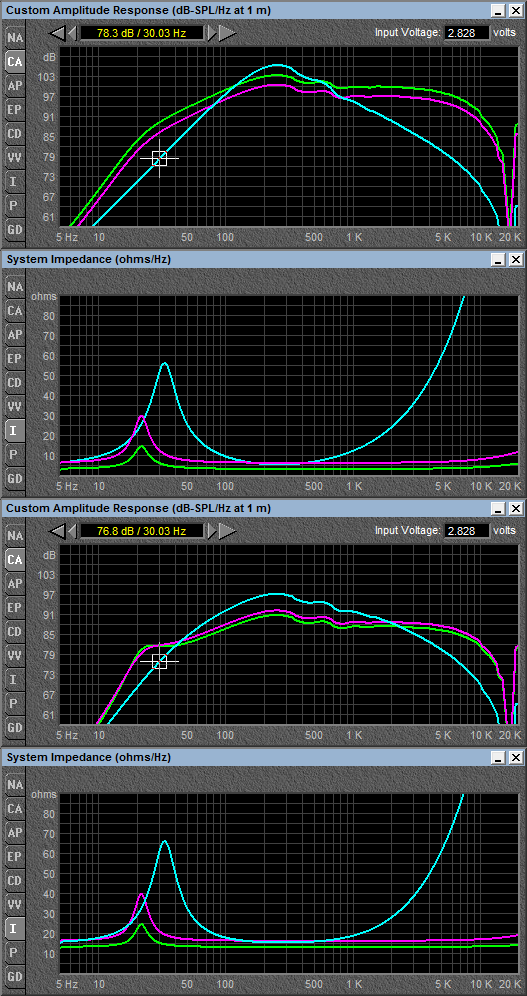
The 15NW100 has a compliance of .134mm/N which is the limiting factor on the low end in this case. The compliance of the Dipole15 is .6mm/N, far softer. This is far more significant than the motor strength in this case. In a sealed or vented enclosure, the compliance of the system is dominated by the air spring in the enclosure. The driver compliance has little effect in such an enclosure. In an open baffle there is no air spring so the compliance of the driver itself is the determining factor. Low compliance means the woofer will roll off far sooner as in the case of the B&C. There is simply no case ever where the B&C can be more efficient down low due to the compliance.
Now that you explain you are modelling with series resistance your response curves make more sense. However, all you are doing is killing the efficiency and in turn creating more thermal issues. The Dipole15 is still far more efficient even with this series resistance of 10ohm applied to each driver. It obviously has more effect at pulling down the level of the dual8ohm version than the dual16ohm. In either case, both are still more efficient down low than the B&C. You are somehow still showing far more efficiency than you should. Perhaps showing what you are using for input into Hornresp will help figure out where the error it.
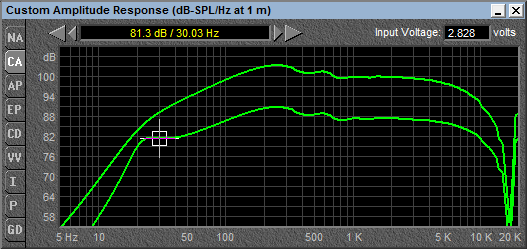
The big issue with series resistance is that adding it causes a significant loss in overall efficiency everywhere. At 30hz there is a drop of 8dB and by 100hz there is a loss of 12.3B with the Dipole15. This is not at all a reasonable trade off. Much more power is required to be applied and much is being wasted in the resistor. In order to realistically do this, a very large resistor bank would need to be made as well. This is one of the situations where there is so much misconception about open baffles. Many recommend doing things that are very counter productive.
- Status
- This old topic is closed. If you want to reopen this topic, contact a moderator using the "Report Post" button.
- Home
- Loudspeakers
- Multi-Way
- Open Baffle woofer what is important?
